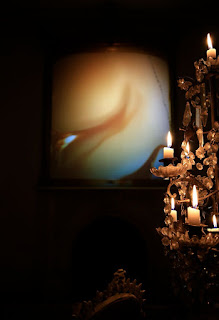David's Spectre of the Spheres was selected for our 2015 Underwood New Music Readings, where it earned him the $15,000 Underwood Commission to write a new orchestral work. David's Chamber Symphony is this new work, and will be premiered by Maestro George Manahan and the American Composers Orchestra at “Past Forward” on Friday, March 24, 2017 at 7:30pm in Carnegie Hall’s Zankel Hall. David was kind enough to talk with us about the piece.
 |
| Composer David Hertzberg |
American Composers Orchestra: Your description of Chamber Symphony, which is very poetic, says, "voices speak to one other across vistas, from different sides of time, finding resonances both sympathetic and volatile." Can you expand upon this? What do you mean by these "voices," "different sides of time," and "resonances both sympathetic and volatile"?
David Hertzberg: When I was awarded the Underwood Commission I knew that I wanted to write something for Maestro Manahan and the ACO that was different from, more rhetorically involved than my other orchestra pieces. I had this vague idea that I wanted it to be a symphony of sorts, whatever that means. The orchestra pieces that I have written up to this point all have flowing, organic forms, in which listeners are brought into a space in which they coexist with a musical organism, breathing and acting of its own accord. My Chamber Symphony, I think, shares this quality, but I feel there is more rhetorical depth in its argument, a gradual unraveling and coalescing of musical dualities - maybe that’s what made me feel the need to call it a symphony.
ACO: Chamber Symphony is your Underwood Commission which you won after participating in the Underwood New Music Readings and Workshops in 2015. Can you talk about anything you learned in the readings and workshops that you applied when composing your commission?
DH: The Underwood readings and the opportunity to work with Mo. Manahan and the ACO have served as an invaluable tool for me as an orchestral composer. In addition to the more pragmatic insights about instrumentation and the orchestra world, hearing them interpret my Spectre of the Spheres in 2015 helped me arrive at the musical conclusions described above, to dig deeper into my own orchestral ethos, and to find the place there wherein a more dynamic musical grammar can blossom.
 |
| David at the 2015 Underwood New Music Readings, rehearsing his piece Spectre of the Spheres with Maestro Manahan and the ACO |
ACO: Can you talk about your composing process for Chamber Symphony? How long have you been working on it? What have been the milestones and challenges throughout the process?
DH: I generally compose by letting the music gestate internally for a long (or not so long) time. When ideas start to congeal, the actual writing part comes quickly, as was the case with this piece, though I had been living with the material for quite some time. I also feel this piece bears the influence of an opera I was (and still am) writing for Opera Philadelphia, freely inspired by the work of the British occultist Aleister Crowley, as well as the poetry of Wallace Stevens, whose deeply human voice has always been a wellspring of inspiration for me.
ACO: How do you hope the audience will feel, and what do you hope they'll notice while listening to Chamber Symphony at its premiere?
DH: It is my hope that listeners will let themselves live in the metaphysical space of this music, and perhaps, feel a certain wholeness, oneness, in the arc of its form.
ACO: What are you most looking forward to at the premiere?
DH: Hearing these notes and sounds that I’ve dreamed up in these past months come to life, and be interpreted in the hands of such sensitive and intrepid (!) artists.
Follow David on Twitter and Soundcloud
Hear the world premiere of David’s Chamber Symphony at “Past Forward” on Friday, March 24, 2017 at 7:30pm in Carnegie Hall’s Zankel Hall.






